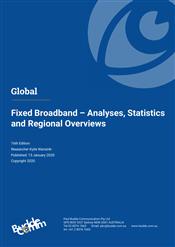2019 Global Fixed Broadband - Analyses, Statistics and Regional Overviews

Last updated: 15 Jan 2020 Update History
Report Status: Archived
Report Pages: 90
Lead Analyst: Sebastien De Rosbo
Contributing Analyst: Henry Lancaster
Publication Overview
This BuddeComm annual publication provides a broad regional overview of fixed broadband infrastructure development around the world including Asia-Pacific, Africa, Latin America, Europe, the Middle East and North America.
It provides insights and analyses into each market, supported by recent fixed broadband subscriber and penetration statistics. The report includes information on South Korea, which has the world’s highest number of broadband services per capita and the United Kingdom, the largest fixed broadband market in Europe.
Researchers:- Kylie Wansink, Henry Lancaster.
Current publication date:- January 2020 (16th Edition)
Executive Summary
Fixed broadband development becomes important for 5G
It is well recognized that fixed broadband plays an important part in future societal developments and underpins the enormous transition to Smart Cities. It is also becoming clearer that fibre-based infrastructure will have an important role to play as the backbone for 5G infrastructure.
From a global perspective, the various regions and countries around the world can vary markedly in terms of fixed broadband development. Overall, Asia continues to be a leading player, not only in the roll-out of broadband infrastructure, but also in promoting and applying the increased use of broadband to facilitate the digital economy.
Asia also continues to be the dominant player globally in the Fibre-to-the-Home (FTTH) broadband market, with countries such as South Korea considered world leaders in this market segment.
In contrast, the development of the fixed-line broadband market in Africa has long been stymied by the lack of fixed-line infrastructure in rural and semi-rural regions, as well as by the poor quality of networks in those urban areas where they are concentrated. As a result, mobile networks provide the principal platform for voice and data connectivity.
In general terms, Latin American countries have moderate fixed-line broadband penetration rates, being generally lower than in Europe but above those found in Africa and parts of Asia.
In Europe, the leading fixed broadband markets, such as France and the United Kingdom, generally started to migrate from copper to fibre networks earlier, and thus have a more advanced fibre infrastructure in place.
The Middle East comprises a variation between its countries in terms of fixed broadband infrastructure development. Israel and Lebanon, for example, have some of the highest fixed broadband penetration in the region. While in contrast, countries like Syria and Yemen have very poor fixed broadband infrastructure due to many years of civil conflict.
The North American market sees the USA investing significantly in fibre deployments and Canada has benefitted from government policies which have encouraged the extension of broadband to rural and regional areas, with the result that services are almost universally available.
Key developments
- For 5G to become a mass market reality; it will not only require the 4G LTE infrastructure, but it will also require fibre broadband.
- Fixed broadband infrastructure has become important for country economic growth.
- Over the next five years to 2024 fixed broadband growth is expected to continue to increase slowly in South Korea.
- Although the UK’s broadband market enjoys excellent cross-platform competition, the sector remains dominated by copper.
Kylie Wansink
January 2020
Related Reports
- Global Fixed Broadband - Analyses, Statistics and Regional Overviews
- BuddeComm Intelligence Report - Key Global Telecom Industry Statistics
- BuddeComm Intelligence Report - The Global Mobile Market in 2020 - Industry Trends and Statistics
- BuddeComm Intelligence Report - Artificial Intelligence, Smart Cities and the Telecoms Sector
- BuddeComm Intelligence Report - 5G Global Trends and Leading Countries
- BuddeComm Intelligence Report - Coronavirus (Covid-19) and the Telecoms Sector
- Global Telecoms - Key Trends for 2020 - 5G, Mobile Satellite and Fixed Broadband
- Canada - Telecoms, Mobile and Broadband - Statistics and Analyses
- Ethiopia - Telecoms, Mobile and Broadband - Statistics and Analyses
- Panama - Telecoms, Mobile and Broadband - Statistics and Analyses
Share this Report
TMT Intelligence
A platform to scale your intelligence tasks
Monitor critical insights with our AI-powered Market Intelligence Platform gathering and analyzing intelligence in real time. With AI trained to spot emerging trends and detect new strategic opportunities, our clients use TMT Intelligence to accelerate their growth.
If you want to know more about it, please see:
Research Methodology
BuddeComm's strategic business reports contain a combination of both primary and secondary research statistics, analyses written by our senior analysts supported by a network of experts, industry contacts and researchers from around the world as well as our own scenario forecasts.
For more details, please see:
More than 4,000 customers from 140 countries utilise BuddeComm Research
Are you interested in BuddeComm's Custom Research Service?
Hot Topics
News & Views
Have the latest telecommunications industry news delivered to your inbox by subscribing to BuddeComm's weekly newsletter.